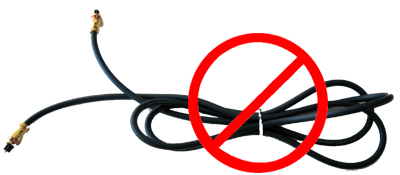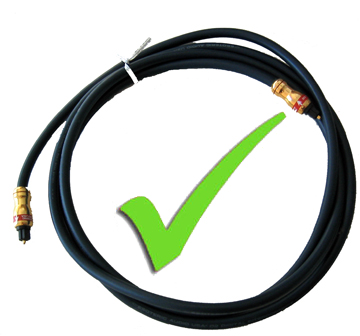
A TechLore "Ask the Experts" Question...
Question:
I recently tried to upgrade my audio on my satellite box by switching to an optical audio connection. However, I couldn't seem to get it to work. The cord that I used was rather long, so I wound it up with a twist tie so the cord wasn't all over my floor. In diagnosing the problem, I tried unwinding the cable and it worked fine!
My question is why does winding up a cable cause it not to work right? I have wound up quite a few of my cables. Should I unwind all of them?
-submitted by LizR
Answer:
Optical cables use light to transmit audio data to a receiver. If you were to dissect the common optical cable, you'd find a thin plastic tube on the inside. This tube has a mirror like finish on the inside that allows the light to bounce down the tube from the device to the receiver. In nearly all cases, not all the information reaches the receiver when it's supposed to, so the receiver runs error correction on the signal to compensate for this.
A sharp bend in the cable forces the light to bounce in an undesirable way, too much data to be lost. If it's severe enough, the receiver may receive too many errors for it to properly compensate and you won't get any sound.
Nearly all other cables are electrical connections, and they work much differently from optical cables. These normally have a solid or stranded core made of metal, and electrical pulses travel along the metal core to reach the destination. A sharp bend won't cause the signal to drop out entirely unless the bend is severe enough to snap the metal. However, bending the cable in most cases causes the inner core to move away from the center, thereby changing the impedance of the cable. This change in impedance can impact the picture or sound quality in a negative way. High end cables have strong dielectrics which keep the core near the center while bent, but severe bends will hurt performance no matter what.


The good news is that you can still wind up your cables to keep the back of your system from looking like spaghetti. You just need to make sure you do it in a way that won't have a major negative impact on performance. For optical cables, makes sure you wrap them in a large circular motion to make sure there are not any extreme angles like in the image above. Electrical cables can be wrapped either way, but the less extreme the bending is, the better your picture or sound will be.
Matt Whitlock - Editor, TechLore.com
Learn more about cables!
Why HDMI is the Clear Choice for HDTV Connectivity - There's a new king of HDTV connections, and its name is HDMI! Learn more about what's going to replace component and DVI forever, and how it will affect the way you watch and record digital television content.
Picking The Right Cables - Confused by how many different types of cables there are out there? Read this to learn how it all got started, and what you should be looking for when shopping for different cables.
Get More Out Of Your Gear!
Home Theater's Biggest Mistakes - Learn the 10 stupid things smart people do when setting up a home theater! In over your head, picture confusion, and so much more that prevent you from getting the most from your home theater experience.
How To Improve A/V Performance By Using the Best Connections
- Learn about all the common video and audio connections like S-Video
and Optical digital audio, as well as which one is the right one to use!




